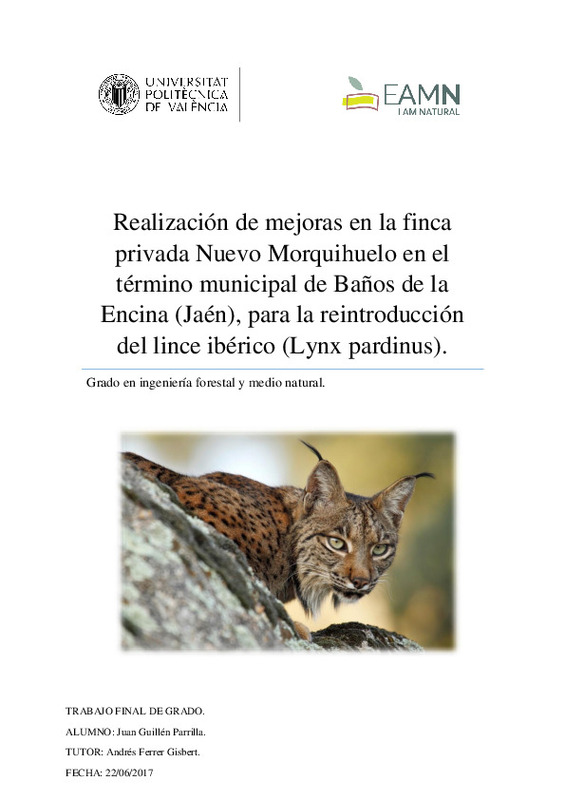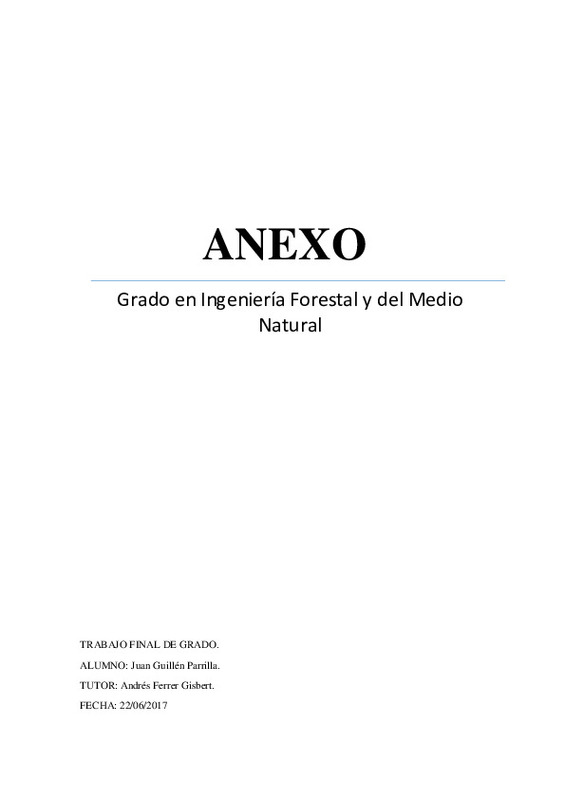|
Resumen:
|
[ES] El lince ibérico (Lynx pardinus) forma parte de la línea de los
grandes carnívoros, siendo una especie endémica de la península ibérica. Se encuentra
protegido por Real Decreto 139/2011, de 4 de febrero, para el ...[+]
[ES] El lince ibérico (Lynx pardinus) forma parte de la línea de los
grandes carnívoros, siendo una especie endémica de la península ibérica. Se encuentra
protegido por Real Decreto 139/2011, de 4 de febrero, para el desarrollo del Listado de
Especies Silvestres en Régimen de Protección Especial y del Catálogo Español de Especies
Amenazadas, desde 1966 cuando empieza la preocupación por la conservación de la especie,
estando actualmente catalogado en la categoría de en peligro de extinción, dado que se estima
que la población de éste felino en la península ibérica es de 400 individuos.
Para tratar de paliar esta situación de la especie, en el año 2002 fue aprobado el proyecto
life “Recuperación de las poblaciones de lince ibérico en Andalucía”. Entonces se había
estimado que quedaban menos de 200 linces en el mundo, distribuidos en dos poblaciones
viables, una en Doñana (Huelva y Sevilla) y otra en Sierra Morena (Córdoba y Jaén). El
objetivo principal de este proyecto era estabilizar las poblaciones de lince ibérico en
Andalucía, asegurando la viabilidad a largo plazo de las dos poblaciones existentes.
Al finalizar el anterior proyecto, en 2006 se puso en marcha un nuevo proyecto life
denominado “Conservación y reintroducción del lince ibérico en Andalucía”. En el marco de
este proyecto se llevó a cabo un paquete de medidas tendentes a dar respuesta a los principales
problemas que afectaban al lince ibérico. Con este segundo proyecto se dio un salto cualitativo
con la inclusión de dos actuaciones novedosas consistentes en la reintroducción de linces en
algunas zonas de distribución histórica en Andalucía, con la creación de dos núcleos de
población: uno en Guadalmellato (Córdoba en 2009) y otro en Guarrizas (Jaén en 2010).
El presente TFG se enmarca dentro de estas actuaciones, estableciendo un conjunto de
mejoras en la finca privada Nuevo Morquihuelo, localizada en el término municipal de Baños
de la Encina, en la provincia de Jaén, dentro del conjunto de actuaciones para la
reintroducción de la especie en las zonas colindantes del Parque Natural Sierra de Andújar,
habida cuenta de los buenos resultados obtenidos entre 2010 y 2015, con idea de potenciarlos
en áreas adyacentes a las de la reintroducción inicial.
La finca ocupa una superficie de 750.has, siendo su aprovechamiento principal la
explotación extensiva de ganado vacuno. Asimismo, existe un aprovechamiento cinegético
por parte del titular de la finca, siendo la presión ejercida muy escasa. Por otra parte, cabe
destacar que las fincas colindantes a la zona donde se realizaran las mejoras presentan una
alta explotación cinegética, siendo esta su mayor aporte de beneficios.
Los trabajos de mejoras en la finca consistirán principalmente en la mejora del hábitat,
mediante un trabajo escalonado, es decir, empezando por la creación de pastizales y majanos,
entre otros trabajos, para aumentar la población de conejos y la instalación y mejora de
charcas naturales y comederos para perdices, así como un buen control de depredadores de
estas dos especies (conejo y perdiz), ya que suponen el alimento base del lince, y siguiendo
con mejoras en el arbolado y refugios naturales para el lince. Durante las actuaciones y una
vez finalizadas se introducirá un calendario de actuaciones periódicas para el mantenimiento
de los trabajos realizados anteriormente, así como la instalación de cámaras para el
seguimiento y registro de datos de los linces en la zona.
[-]
[EN] The Iberian lynx (Lynx pardinus) forms a part of the line of the big
carnivorous ones, being an endemic species of the Iberian peninsula. It is protected by royal
decree 139/2011, of February 4, for the development ...[+]
[EN] The Iberian lynx (Lynx pardinus) forms a part of the line of the big
carnivorous ones, being an endemic species of the Iberian peninsula. It is protected by royal
decree 139/2011, of February 4, for the development of the List of Wild Species in Regime
of Special Protection and of the Spanish Catalogue of Threatened Species, from 1966 when
it begins the worry for the conservation of the species, being catalogued nowadays in the
category of on the verge of extinction, provided that it thinks that the population of feline this
one in the Iberian peninsula belongs 400 individuals.
To try to relieve this situation of the species, in the year 2002 the project was
approved life "Recovery of the populations of Iberian lynx in Andalusia ". Then it had
thought that less than 200 lynxes were staying in the world, distributed in two viable
populations, one in Doñana (Huelva and Seville) and other one in Sierra Morena (Cordova
and Jaen). The principal aim of this project was to stabilize the populations of Iberian
lynx in Andalusia, assuring the long-term viability of both existing populations.
On having finished the previous project, in 2006 a new project was started life
called "Conservation and reintroduction of the Iberian lynx in Andalusia ". In the frame
of this project there was carried out a package of measures tending to give response to the
principal problems that were concerning the Iberian lynx. With this second project one
gave a qualitative jump with the incorporation of two new actions consisting of the
reintroduction of lynxes in some zones of historical distribution in Andalusia, with the
creation of two cores of population: one in Guadalmellato (Cordova in 2009) and other
one in Guarrizas (Jaen in 2010).
The present TFG places inside these actions, establishing a set of improvements
in the private estate New Morquihuelo, located in the municipal area of Baños de la
Encina, in the province of Jaen, inside the set of actions for the reintroduction of the
species in the zones adjacent to the Nature reserve It Saws of Andújar, given the good
results obtained between 2010 and 2015, with idea of them promoting in adjacent areas
to those of the initial reintroduction.
The estate occupies a surface of 750.has, being his principal utilization the
extensive exploitation of cattle. Likewise, a hunting utilization exists on the part of the
holder of the estate, being the exercised very scanty pressure. On the other hand, it is
necessary to emphasize that the adjacent estates to the zone where the improvements
should realize present a high hunting exploitation, being this his major contribution of
benefits.
The works of improvements in the estate will consist principally of the
improvement of the habitat, by means of a work staggered, that is to say, beginning for
the creation of pastures and landmarks made of a pile of stones, between other works, to
increase the population of rabbits and the installation and improvement of natural pools
and feeding-places for partridges, as well as a good control of predators of these two
species (rabbit and partridge), since they suppose the food base of the lynx, and continuing
with improvements in the woodland and natural refuges for the lynx. During the actions
and once finished there will interfere a calendar of periodic actions for the maintenance
of the works realized previously, as well as the installation of cameras for the follow-up
and record of information of the lynxes in the zone.
[-]
|








